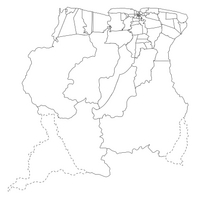Coeroeni
Coeroeni | |
|---|---|
UTC-3 (AST) |
Coeroeni is a resort in Suriname, located in the Sipaliwini District. Its population at the 2012 census was 1,046. The resort is mainly inhabited by indigenous people[1] of the Tiriyó tribe.[2] Kwamalasamutu is the main village of the resort and home to the granman (paramount chief) Asongo Alalaparu.[3]
The resort was created in 1983 out of Nickerie as a tribal area.[4] The disputed area of south-west Suriname known as Tigri Area belongs to the Coeroeni resort.[5]
Villages
- Alalapadu
- Amatopo
- Kasuela (disputed)
- Kuruni
- Kwamalasamutu
- Sakuru (disputed)
- Sipaliwini Savanna
- Vier Gebroeders
The resort is also home to villages which are only inhabited part of the time.[6]
Kamani
Kamani is a border village. It was founded in 2008 by people from Kwamalasamutu.[7] The population as of 2009 was 6 people.[8] The location is 2°34′5″N 57°0′30″W / 2.56806°N 57.00833°W.
Nature

The Sipaliwini Savanna is a 100,000 hectare
Archaeology
The
Notes
- ^ a b "Resorts in Suriname Census 2012" (PDF). Retrieved 18 May 2020.
- ^ "DORPSPLAN KWAMALASAMUTU 2011–2014" (PDF). Institute for Graduate Studies and Research (IGSR) (in Dutch). Archived from the original (PDF) on 15 June 2020. Retrieved 27 May 2020.
- ^ Heemskerk & Delvoye 2007, p. 100.
- ^ "Districtenindeling Suriname - herstel oude grenzen district Nickerie". nickerie.net (in Dutch). Retrieved 17 June 2020.
- ^ "Suriname, Guyana in Dispute Over Mineral-Rich Land". Atlanta Black Star. 12 May 2014. Retrieved 25 May 2020.
- ^ "Planning Office Suriname - Districts" (PDF). Planning Office Suriname (in Dutch). Retrieved 23 May 2020.
- ^ Amotopoan trails : a recent archaeology of Trio movements - Page 5. University of Leiden (Thesis). Leiden University. 26 September 2012. Retrieved 15 June 2020.
- ISBN 978-9460220-265.
- ^ "Natuurreservaten Suriname". Reisgraag (in Dutch). Retrieved 16 June 2020.
- ^ Burton Kim & Thomas E. Lee Jr (2018). "Community Ecology and Phylogeography of Bats in the Guianan Savannas of Northern South America" (PDF). MDPI. Retrieved 17 June 2020.
- ^ "Zoology". Sipaliwini Savanna. Retrieved 16 June 2020.
- . Retrieved 16 June 2020.
- ^ "My Beloved Nickerie". Nickerie.com. Retrieved 17 June 2020.
References
- Heemskerk, Marieke; Delvoye, Katia (2007). Trio Baseline Study: A sustainable livelihoods perspective on the Trio Indigenous Peoples of South Suriname (PDF). Paramaribo: Stichting Amazon Conservation Team-Suriname.

